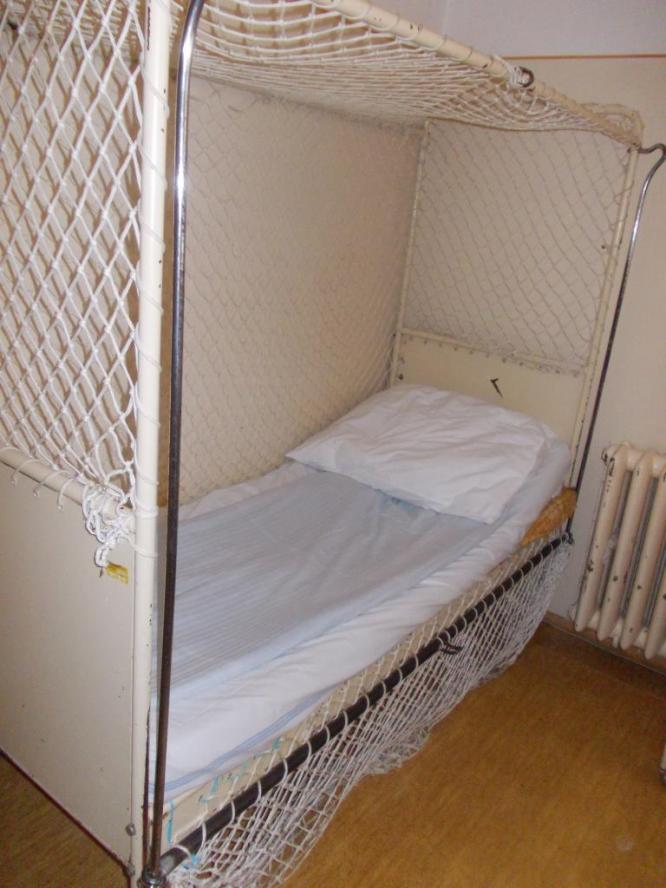7(B)(ii). Observations
MDAC found that leather straps and other physical restraints are commonly used in many psychiatric institutions, sometimes in combination with cage beds and very often with chemical restraints.
In 2006, registration of the use of restraints in psychiatry became compulsory in a computer system, and also in a register held by each hospital. Despite this, no national statistics are available to the public. Hospitals have their own guidelines on the use of restraints (MDAC was shown these at Prague Bohnice, Kosmonosy, Opařany, Opava and Dobřany hospitals). The guidelines regulate clinical and related practices inside psychiatric settings and are required by law. Some specify that a record must be made of a patient’s behaviour before the use of restraints, that restraints must have prior authorisation by a doctor (apart from “in exceptional cases”, a phrase which is undefined), and some also outlined the maximum time period that straps could be applied.
At Prague Bohnice Psychiatric Hospital the maximum time allowed for the application of straps was three hours, but a staff member told MDAC that in the previous year a patient had been strapped for nine hours. At Opava Psychiatric Hospital the maximum period was 12 hours, and at Kosmonosy Psychiatric Hospital there was no limit and decisions on length of time for strapping were entirely at the doctor’s discretion.
In some of the institutions, internal policies specified the situations when the court must be notified of the use of straps. At Opava Psychiatric Hospital, if a person is an involuntary patient then the court is notified about the use of restraint. Court notification is not required, however, if the patient gives his or her “consent” to the restriction within the 24 hour period following removal of the restraints. This creates an obvious way to avoid the notification requirement, allowing hospital staff to exert pressure to obtain retrospective consent. It is a nonsensical provision.
Seven pointrestraint for children
Seclusion rooms were used in Opařany Children’s Psychiatric Hospital where they are known as “rooms of individual surveillance”. They were in both the boys’ and girls’ wards. In the boys’ ward, the room was quite small with a bed on the right-hand side of the room and a soft green mattress next to the bed. The room was light green and white with tiles on the floor.
The one bed in the room had seven-point straps attached (the seven points of attachment are to the left and right ankles, left and right wrists, chest, and left and right shoulders), ready for use. The straps were not hidden from view as the director had told the monitoring team they would be. The monitoring team also ascertained that the children knew of the existence of the straps which they viewed with fear, illustrating that mere knowledge of their existence had a coercive effect.
The official line of most psychiatric hospital directors interviewed was that restraints are only used as a “last resort”. They told MDAC that nurses are trained to deal with “difficult” patients, and the first line approach is manual holding, although no evidence of this was provided. Injections and straps are the most common restraints, according to one hospital director, but no data is available.
Straightjackets – euphemistically referred to as “protective jackets” by some senior staff at Opařany Children’s Psychiatric Hospital – are used rarely, but again no data was available to verify this assertion, and they were not shown to the monitoring team At Opava Psychiatric Hospital the deputy director said that a straightjacket had been used once in the previous year, though again no data was available.
Many types of straps
The monitoring team found that leather and fabric straps are prevalent across Czech psychiatric institutions.
1. Some leather straps have a layer of fleece on the side of the strap which touches the skin of the patient so that it feels soft.
2. Other hospitals use white canvas straps, with buckle fastenings or magnetic locks.
3. In wards for elderly people abdominal straps are used, as well as boards on the sides of hospital beds, and sometimes one limb of a patient is strapped to prevent them from falling.
4. A special jacket attached to the sheet of a bed is used in some institutions. Once a patient is inside one of these jackets, the jacket “brings him back to the bed” if they try to get up, according to staff at Prague Bohnice Psychiatric Hospital.
At Plzeň Hospital Psychiatric Department, a psychiatrist told MDAC that they used straps to restrain a patient’s wrists and ankles, and if they were “very aggressive” the staff would tie a bed-sheet over the patient’s chest. At Opava Psychiatric Hospital staff said that straps were usually used on patients’ wrists and legs and only “in exceptional cases” on the chest. Straps were used for “patients that are restless and have a tendency to stand up”. Chemical restrictions are always used in conjunction with straps, “to treat the source of the restlessness.” According to staff, they monitored strapped patients every 20 minutes. Elsewhere, such as at Lnáře Psychiatric Hospital, strapping seemed to occur less frequently.
 Photos: Klatovy Hospital Psychiatric Department © MDAC
Photos: Klatovy Hospital Psychiatric Department © MDAC

